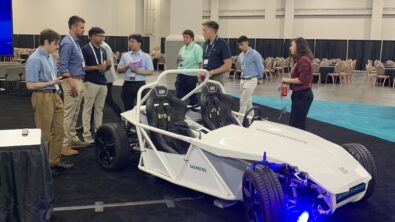UT-Brownsville student builds Rocket Engine Nozzle using NX
The University of Texas at Brownsville student Michael Barrera recently won the Siemens PLM Software student design contest.
Learn more about him and his winning design in the following Q&A.
What is your field of study?
“Bachelors of Science in Engineering Technology, University of Texas Brownsville.”
Why did you choose this project/design – what gave you the idea?
“I came up with this unique rocket engine design to really show more of my interest in possibly pursuing a career in aerospace, possibly becoming a design engineer with SpaceX. I have always been fascinated with space, the universe, and the sciences in general since I was young. This design came to fruition after a brainstorming session for completing a class final project incorporating what we had learned for the semester and also including what my goals are for finishing my bachelors. I had intended to use this project as part of my portfolio of designs.”
What challenges did you face during the design/build?
“The most difficult phases of this project were working in the assemblies portion of NX9, specifically with all of the smaller individual parts I had created such as the bolts and mounting areas for the hydraulics.”
Additionally, “I had some trouble lining up the rings and coolant pipes that were to be attached to the exhaust nozzle. Also, the fuel and oxidizer pipes that enter into the red combustion chamber were a challenge to line up without having them intersect.”
What features of NX did you use to develop your project?
“In part creation, I used the Extrude and Revolve features extensively. I used the Array feature to make it easier creating holes throughout the main body where bolts would be used for assembly. I had also tried working with Conics, a feature that we had not been instructed on its use, to form the shell for the exhaust nozzle. I had played around with that feature until I got the hang of it and was able to incorporate it as well as the Offset feature. Another feature that I began to try and work with that we had not been instructed on was the Helix feature. This was used for creation of the fuel and oxidizer pipes that were to feed into the combustion chamber.
Other features used were the Hole feature, Mirror and Copy feature, and the Pad and Draft features. I made use of creating additional Datum Planes as well as taking the liberty to play around with many of the settings within the View and Render portions of NX.”
Would you recommend NX to another student? Why or Why not
“Absolutely! This project was for a grade for the design class I was enrolled in, which two are required for this degree I am pursuing. The first portion of the design class I had taken a few semesters ago dealt with AutoDesk Inventor, and I felt that NX was a much more fully realized software suite better suited for projects such as these. I will say that I do come from more of an artistic graphic design background, previously being an Art Major. However, my previous software experience was focused on Adobe Illustrator and Photoshop. So I can say that using software like this was a new experience for me, but I take to learning new software like this much easier than most. This is a very easy program to learn without major difficulty.”
Congratulations to Michael!



